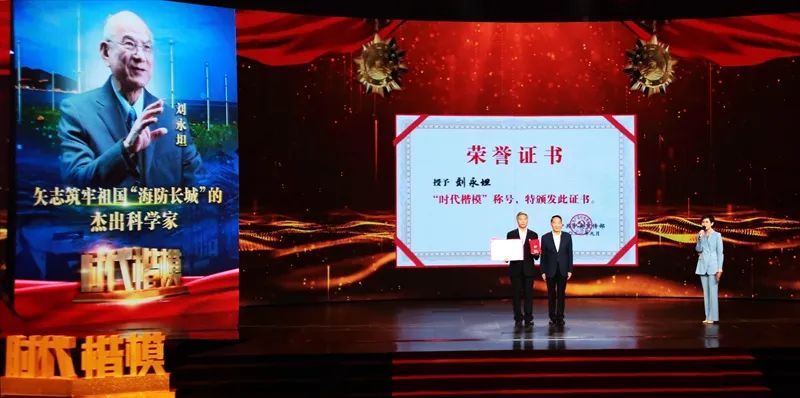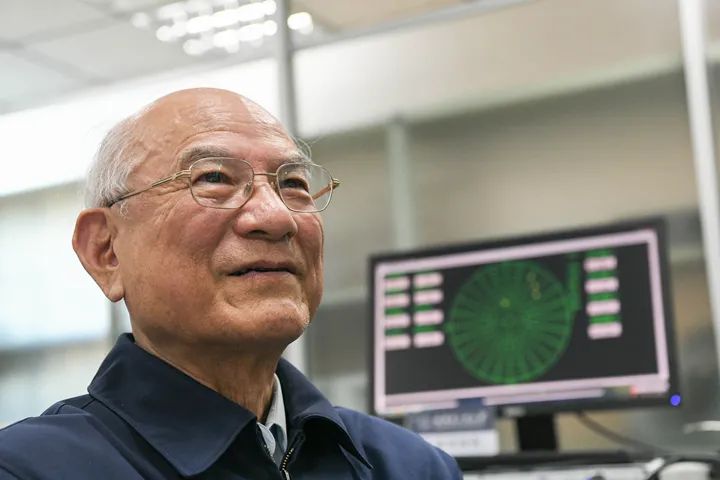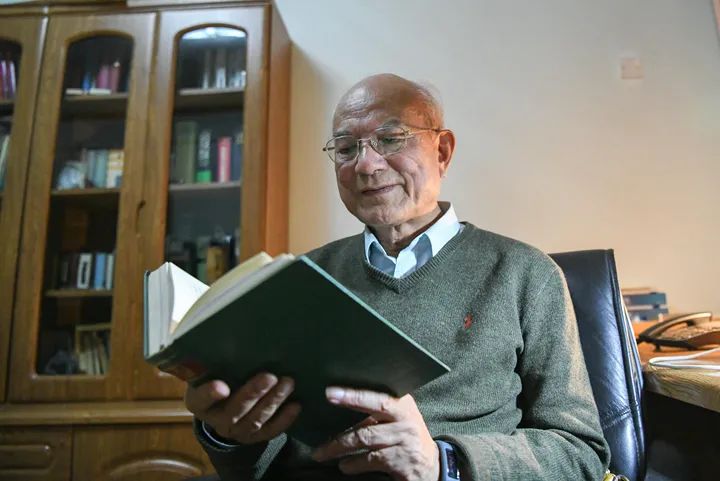On September 29, the Propaganda Department of the Central Committee of the Communist Party of China issued the decision to grant Liu Yongtan the title of “Model of the Times”; that evening, CCTV-1 “Models of the Times Release Hall” broadcasted a report by Academician Liu Yongtan, an outstanding scientist who was determined to build the “Great Wall of Coastal Defense” in the motherland. Advanced deeds… Suddenly, social attention, media focus, this old man once again attracted millions of attention.

On September 26, the representative of Comrade Liu Yongtan received the “Model of the Times” medal and certificate for Liu Yongtan.Xinhua News Agency
Liu Yongtan is a well-known expert in radar and signal processing technology, the founder and leader of radar theory and technology in the new system of sea detection, an academician of the Chinese Academy of Sciences, an academician of the Chinese Academy of Engineering, and a professor of Harbin Institute of Technology. It is such a “model of the times” who insists on family and country feelings and is committed to serving the country with science and technology. He has a deep relationship with Weihai. In 1988, Liu Yongtan led a team to successfully develop and establish my country’s first new system long-range radar experimental system on the Weihai coast. . Since then, he has been walking continuously, breaking through a series of key technologies, cultivating outstanding talents, casting a country’s important weapon, and casting a thousand-mile vision for the motherland’s sea and territories.
On September 30, the reporter walked into the radar station of Harbin Institute of Technology (Weihai). Here, the reporter met Professor Yu Changjun, the director of the Harbin Institute of Technology (Weihai) Electronic Engineering Institute and the head of the radar station who had just returned from receiving the award on behalf of Academician Liu Yongtan in Beijing, and listened to him telling the story of Academician Liu Yongtan overcoming difficulties in 40 years.
 Yu Changjun accepted an interview with our reporter and talked about the advanced deeds of Academician Liu Yongtan.Photo by our reporter Sun Dawei
Yu Changjun accepted an interview with our reporter and talked about the advanced deeds of Academician Liu Yongtan.Photo by our reporter Sun DaweiHandwritten more than 200,000 characters, won the new system radar project
Only by seeing far can we protect our seas far. The new system of radar can break through the “blind areas” of traditional radar detection to find targets.
In the early 1980s, with a strong sense of concern for the country and profound scientific literacy, Liu Yongtan had the ambition to study long-distance detection equipment, and was determined to completely change my country’s backwardness in sea exploration.
However, for such a major national demand, there is no theory or technology that can be used for reference. “At that time, similar radars in the world were also in the initial stage of exploration, and they were tightly sealed.” Yu Changjun said that the research on this technology poses great risks to the team and Liu Yongtan personally, and it may not be possible for decades. Any results may be unknown for a lifetime.
But Liu Yongtan always firmly believes that self-innovation and new ways are the only way to break through scientific problems. In order to win the support of the Preliminary Research Department of the Ministry of Aerospace Industry at that time, the team produced a “Overall Plan Demonstration Report of the New System Radar” within a few months of more than 200,000 words.

Liu Yongtan (second from right) is studying radar technology in the laboratory of Harbin Institute of Technology (photographed on December 25, 2018).Xinhua News Agency
This 200,000-word report was handwritten by the team members one by one. At that time, there were no computers, keyboards and screens, not to mention printers, A4 paper, and only ink and ordinary manuscript paper. “Imagine a page of 300 words on manuscript paper, and a project report alone would require more than 700 pages, all handwritten.” Yu Changjun recalled that the pile of waste paper alone was half a meter high.
At that time, together with Liu Yongtan, six people studied at the desk, worked hard to write, and there were countless “drinking” ink bottles. The “kung fu” of fast writing was practiced at that time.
The new system of radar involves signal transmission, reception, information extraction and other links. Everywhere, Liu Yongtan requires everyone to realize theoretical and technological innovations, test them in practice, and repeatedly exercise thousands of times before they can pass.
He led the team to start from scratch, and the system broke through basic theoretical problems such as ground wave excitation principle, multi-type target scattering characteristics, sea clutter background target detection mechanism, etc., created a new system detection theoretical system, and realized the major original coastal defense early warning technology. Innovation.
In July 1986, the Ministry of Aerospace Industry held a key technical achievement appraisal meeting for the new system radar at Harbin Institute of Technology and gave it a high degree of recognition. Since then, the new system radar has been listed as a national science and technology application and basic research project from a pre-research project.

Liu YongtanIn the laboratory of Harbin Institute of Technology (photographed on December 25, 2018).Xinhua News Agency
Started from nothing in Weihai and built the country’s first radar station with a new system
“Scientific research results cannot be transformed into practical applications. It is like a sword without an edge. It is not useful.” In 1986, Liu Yongtan proposed the idea of establishing a new radar experimental station.
Where is the radar station built? This became the first problem facing Liu Yongtan and everyone. The new system radar is mainly to observe the sea, and the radar station must also be built on the seashore. At first, some people recommended the Qidong coast in Jiangsu, and some people turned their attention to Liugong Island in Weihai, Shandong.
After many considerations and careful choices, Liu Yongtan finally chose the seaside of the newly established Weihai campus of Harbin Institute of Technology. At that time, the Weihai campus of Harbin Institute of Technology had just built the first teaching building, and the entire campus was a wasteland except for the orchard. However, Liu Yongtan believes that the construction of the radar station must rely on the Weihai campus and will also contribute to the future development of the campus.
In 1988, with the support of the school and the local government, China’s first new system radar experiment station started construction on the beach of the Weihai campus. Because the new system radar is different from the previous microwave radar, the engineering is very difficult, and after the approved funds are purchased the necessary instruments and equipment, there is not much money left at the disposal.
Someone in the team stunned, and Liu Yongtan said sonorously: “If there is no difficulty, what is scientific research!”
The site was chosen far away from the crowd. The researchers lived in a simple house with air leakage on all sides. They worked more than ten hours a day and worked for several months.
Life is inconvenient, they often use cold bread to fill their hunger; traffic is inconvenient, they brave the wind and rain, one-way walk 3 kilometers to and from the station and radar station… Liu Yongtan led everyone not to back down, but to try their best to win support from all sides to tide over the difficulties.

Liu Yongtan (front right) is studying radar technology in the laboratory of Harbin Institute of Technology (photographed on December 25, 2018).Xinhua News Agency
In 1989, the new radar experimental system was completed, and the Chinese took eight years to catch up with the Western countries for 20 to 30 years. In 1991, the new system radar project won the first prize of the National Science and Technology Progress Award, and Liu Yongtan was elected as a member (academician) of the Chinese Academy of Sciences.
He devoted his life to the development of my country’s radar industry and led the team to successfully build my country’s first all-weather, all-weather, and long-range detection function for the sea new system radar. He has made outstanding contributions to accelerating the construction of a scientific and technological power and a maritime power. He won the 2018 annual The highest national science and technology award.
Over the years, the team led by Liu Yongtan has grown from 6 to more than 30 people. He has built a “Radar Iron Army” in his alma mater, Harbin Institute of Technology, to bring out the “dream of three generations of old, middle-aged and young talents in the new system radar field.” Team”. He led the team from the experimental field to the application field, focusing on the practical application of the new radar experimental system.
The Weihai radar station has bred two first prizes for national scientific and technological progress, and now it still carries the research tasks of new technologies and new mechanisms, and has become the outfield experimental base of the key laboratory of maritime monitoring and information processing of the Ministry of Industry and Information Technology.
“Even after so many years, when we mention the Weihai radar station, Academician Liu Yongtan still has deep feelings for this place.” Yu Changjun said that since 1990, Liu Yongtan will return to Weihai every year to stay for a while and concentrate on research.
There are beautiful beaches here, and seagulls chirping loudly from time to time. The upright radar antenna array is like this smart and brave spirit, never stopping to catch signals from the ocean. In Liu Yongtan’s view, they seem to have already lived. They are “special members” of the team, condensing the life’s hard work and dreams of many people.
Thirty fame, dust and soil, eight thousand miles, clouds and moon. Now, Liu Yongtan, who is in his old age, still hasn’t stopped.
Promoted by his design, the “21st Century Radar” will be used in navigation, fisheries, coastal oil development, marine climate forecasting, coastal economic zone development and other fields to benefit the people.
“One task is completed, and the next one must be started. Only when products with better performance are developed can we give the country a satisfactory answer.” He said.
“Academician Liu Yongtan once said,’The needs of the country are our needs, and the needs of the country are our personal pursuits.’ As his students, we will continue to be in Weihai, where our teachers sweat our youth, and face the future of the country. In order to meet the strategic needs of the open sea, the plan and implementation of the systematic research on the long-range sea exploration will contribute to the construction of the “Great Wall of Coastal Defense”.” Yu Changjun said.

Liu Yongtan reads books at home (photographed on December 25, 2018).Xinhua News Agency
zhuan let more people know~~
Sign and review: Ma Chunhong
Review:Wang Haojie
Editor: Zhang Xiaofeng


